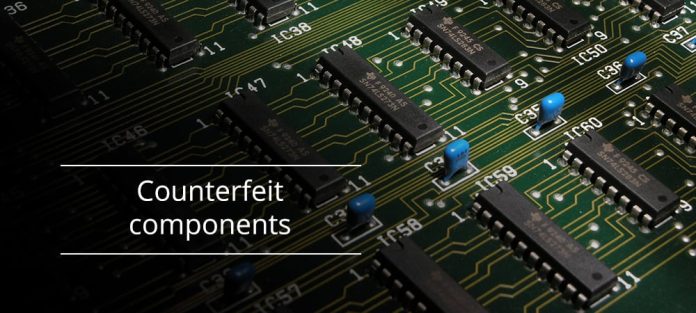The existence of counterfeit electronic components has become a vital danger to not just the electronic industry but to the global supply chains, stating the exponential growth in its market over the years.
Electronics is a hugely profitable industry, and the growth in global suppliers and distributors is also seen with a corresponding increase in nefarious participants and fraudsters trying to reap profits and capitalize on this potential. According to reports- the fake semiconductor industry procures a whopping $75 billion risk, while the electronics account for another $169 billion. It is also estimated that the global trade market of counterfeit electronic components is worth up to $1 trillion and can potentially reach $ 4.5 trillion annually.
Manufacturing of counterfeit electric, electromechanical, and electronic (EEE) components is common, but this industry is growing by the day, leaving manufacturers with hefty fines, harming the lives of the common man, and also jeopardizing national security.
Understanding the Story Behind Counterfeit Electronic Components
A counterfeit is an illegal/ unauthorized copy of an original electronic component that is misrepresented as a product of an original equipment manufacturer (OEM)/authorized manufacturer. A counterfeit electronic part does not conform to the regulatory measures adopted by OEMs like design, model, or performance. It can also be an off-specification, defective, or used OEM part sold as new or working and possesses wrong or false markings and documentation.
Looking closely at the statistics, there has been a nearly 35% increment in the counterfeit components industry in 2022, and 2023 can expect the percentage to increase further. It is reported that Xiaomi seized more than 3000 counterfeit products in the year 2020, and the number of counterfeit products rose to 9000 in just the half-yearly term of 2022.
The counterfeit components appear just the same as the original part/product but are prepared using subpar materials and inferior craftsmanship. This reflects in their poor performance and abrupt failure of the operation. This results in less productivity, hefty fines, lawsuits, safety risks, and brand damage. There have been many incidents of fraudulent components being used in the supply chains, which cost billions to the manufacturer. Some reported incidents of counterfeit components are- a counterfeit semiconductor component caused a fire in the control circuitry in a vacuum cleaner, a counterfeit semiconductor failed in a power supply used for airport landing lights, a broker shipped counterfeit semiconductors intended for use in nuclear submarines, a broker shipped counterfeit microcontrollers intended for use in baking systems in high-speed trains in Europe. In the light of increasing counterfeit components market worldwide, Samsung’s unit Harman- an audio product brand, seized counterfeit JBL and Infinity car speakers and subwoofers from shops in Delhi.
Some electronic components that are commonly counterfeited are – resistors, capacitors, microcontrollers, semiconductors, transistors, etc. The five most commonly counterfeited semi-conductor types include- analog integrated circuits (ICs), microprocessors, memory ICs, programmable logic devices, and transistors. A faulty counterfeit analog IC can cause serious tragedy in the aviation, medical, military, nuclear, or automotive sectors, not to forget the excessive cost of rework, repair, and customer returns for component failures.
Problems and Risks attached with Counterfeit Electronic Components
The global electronics supply chain is actively engrossed in dealing with counterfeit electronic components which has become an issue of paramount importance. Several factors contribute to the expanding counterfeit problem faced by the electronic industry on a global level.
Owing to a huge difference in the supply-consumption rate, increased demand leads to a shortage of products which in turn gives the counterfeiters the window to operate. Counterfeiters are quick to take advantage of such opportunities to make easy money. Also, the replacement of obsolete products often leads to purchases from brokers or online exchange services instead of franchised or independent distributors. Under such circumstances, OEMs are mostly unidentified.
With the rise in technology and the evolution of the internet, nothing seems impossible. The Internet has given birth to many online platforms allowing buyers and sellers to communicate in no time. Middlemen in the supply chain very often discard or re-sell electronic components that fail regulatory specifications and audits. These components are readily sold by counterfeiters on many websites and e-commerce platforms.
The event of counterfeiting happens in regions/ countries where supply chains are extremely intricate and intellectual property laws are not strictly followed.
There also exists the problem of weak brand protection. Generic labels made using legacy technologies (legacy holograms) with no clear validating visual aspect or striking elements are way easy to counterfeit. To fight counterfeiting, the electronic component industry needs upgraded security labels that are backed by cutting-edge technology that is extremely difficult to copy, but easy to authenticate.
There is excessive use of technology to produce cheap and counterfeit parts that appear authentic and the same as OEM products. Various procedures including – acid washes, surface sanding, and exposure to open flames are used to replicate the original component.
The developing world is facing a huge problem of hazardous electronic waste being exported by a few developed countries, making them the hotspot of counterfeit electronic components and their repercussions. Counterfeiters take advantage of the easily available cheap raw material, which they procure at little to no cost.
How to Play Safe in the Electronics Market
The two common methods to identify a counterfeit electronic component are visual inspection and electrical test; each involves several tests that are done according to the component under examination. It is best to conduct test procedures created by original manufacturers, since third-party inspections and tests might not be reliable enough and generally come with their terms and conditions.
Maximizing supply chain visibility and transparency in the upstream supply partners is a must. As per reports, 45% of the organizations are only acquainted with their first-tier suppliers. Organizations need to inculcate better, stronger, and more efficient data-sharing practices with the supply chain partners. This can be effectively handled using IoT-led solutions and cloud dashboards.
Electronic components can be sourced from these four options- original manufacturers, distributors, brokers, and catalogue suppliers. Many manufacturers turn to distributors and brokers to sell their products due to the availability of multiple selling channels, but this can get risky sometimes. Therefore, it is advised to source the products from original manufacturers or authorized distributors. Also, in some cases, detailed insurance policies can help reduce the risk of counterfeiting and its effect.
A rigorous check when shipping the components is always called for. Visual inspection to check any obvious defects in the parts, packaging, labels, or incorrect spelling errors should be done. Many a time, counterfeits appear too convincing, thus visual inspection doesn’t solve the purpose. X-rays, metallurgy analysis, and similar tests must be undertaken for highly sensitive components.
Manufacturers should opt for blockchain technology to locate the components as separate blocks in the chain. This way they can verify precisely where the parts came from and when they arrived in the supply chain.
To give a reliable insight into electronic components distribution, we have summarised a list of global distributors you can trust and work with.
- Mouser Electronics India Pvt. Ltd.
- Digi-Key Corporation
- Element 14 India Pvt. Ltd.
- Allied Devices (Singapore) Pte Ltd.
- Arrow Electronics Inc.
- Avnet Technology Solutions India Pvt. Ltd.
- RS Components
- TME
Conclusion
In a nutshell, as a manufacturer and a supplier in the electronics industry, one must ensure that the supply chain management is strong and best practices are applied for counterfeit prevention and detection, including procurement and testing approaches.











